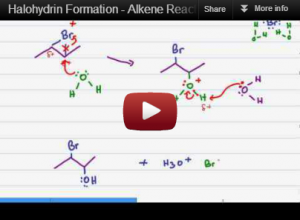 Alkene Reactions Series: Video 5
Alkene Reactions Series: Video 5
This tutorial takes you through the halohydrin formation mechanism, a type of electrophilic addition which adds both a halogen and alcohol to an alkene by using water instead of an inert solvent like CH2Cl2 or CCL4 to yield a halohydrin which features both a halogen and alcohol on the carbon chain
This video provides with a step by step breakdown of the mechanism and helps you understand WHY this reaction undergoes anti addition and still follows Markovnikov’s rule.
(Watch on YouTube: Halohydrin. Click cc on the bottom right for video transcription.)
<– Watch Previous Video: Halogenation of Alkenes Reaction Mechanism
–> Watch Next Video: Acid Catalyzed Hydration of Alkenes
This is Video 5 in the Alkene Reaction Mechanisms Video Series. Click HERE for the entire series.
Ready to test your skills? Try the Alkene Reactions Practice Quiz after watching the series!


